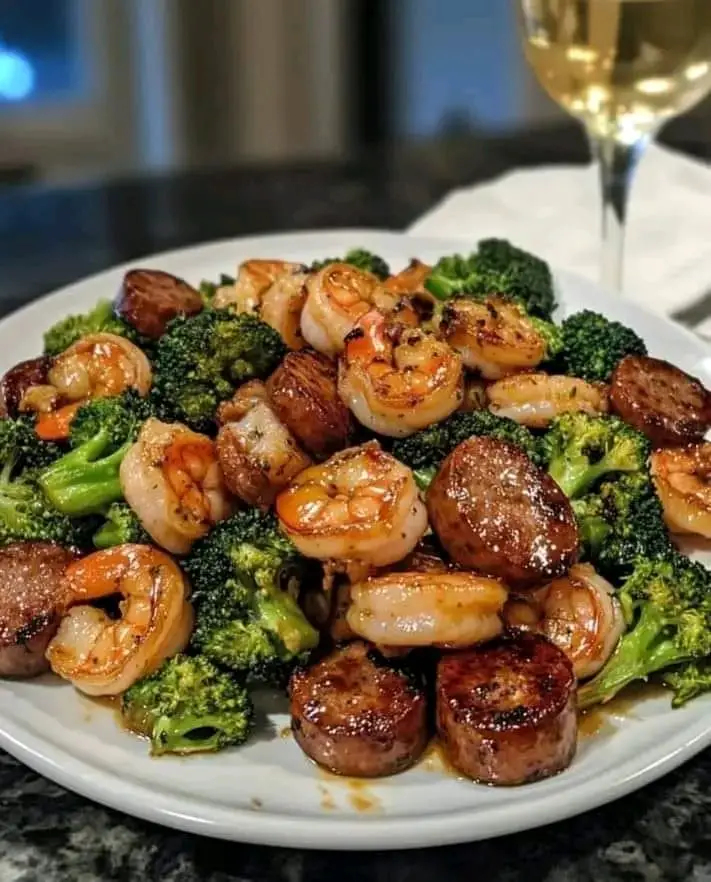The 10-Minute Dinner Hiding in Your Freezer?
What if a vibrant, healthy, home-cooked dinner was consistently faster than ordering takeout? Here in Marrakesh, the souks are a masterclass in preparation; vendors have their spices perfectly ground and their vegetables neatly chopped, ready for the evening’s tagines. It’s a lesson in efficiency that inspired me to master my own kitchen prep. This isn’t just a recipe; it’s a guide on how to make stir-fry freezer meals that will revolutionize your weeknights. It challenges the notion that freezer meals are bland and mushy, proving you can have a delicious, crisp-tender stir-fry on the table in about 10 minutes, straight from the freezer.
- The 10-Minute Dinner Hiding in Your Freezer?
- The Building Blocks of Your Stir-Fry Freezer Pack
- Timing
- Step 1: Make the All-Purpose Stir-Fry Sauce
- Step 2: Prepare and Marinate the Protein
- Step 3: Chop and Prep Your Vegetables
- Step 4: Assemble Your Stir-Fry Freezer Meals
- Step 5: Cooking Your Stir-Fry From Frozen
- Nutritional Information
- Healthier Alternatives for the Method
- Serving Suggestions
- Common Mistakes to Avoid
- Storing Tips for Your Freezer Meals
- Your Secret Weapon for Busy Weeknights
- FAQs
The Building Blocks of Your Stir-Fry Freezer Pack
The key to a great freezer stir-fry is using the right components. Think of this not as one rigid recipe, but as a customizable formula. The ingredients listed below are for a classic chicken and bell pepper stir-fry, but the possibilities are endless.
Example: Classic Chicken & Veggie Stir-Fry Pack
| Component | Ingredient | Notes & Substitutions |
| The Protein | ¾ to 1 lb chicken breasts or thighs | Slice thinly. Pork, beef, shrimp, or firm tofu also work beautifully. |
| The Aromatics | 2 cloves garlic, smashed & 1 bay leaf | These infuse the protein with flavor. Ginger slices are another great option. |
| Hardy Vegetables | 1 bell pepper (1 cup chopped) | Carrots, broccoli florets, or sliced onions freeze very well. |
| Tender Vegetables | 1 cup sugar snap peas | Green beans, asparagus tips, or bok choy are excellent choices. |
| The Grain (Prep on cooking day) | ½ cup uncooked rice per serving | Cook white or brown rice fresh for the best texture. |
The Go-To Stir-Fry Sauce:
| Ingredient | Amount | Notes & Substitutions |
| The Base | 2 tbsp soy sauce | Use tamari for gluten-free or coconut aminos for a soy-free option. |
| The Wine | 2 tbsp dry sherry | Mirin or any dry white wine works well. |
| The Liquid | 2 tbsp water or broth | Chicken or vegetable broth adds more flavor. |
| The Sweet | 2 tbsp brown sugar | Honey or maple syrup are great substitutes. |
| The Acid | 1 tbsp rice wine vinegar | Adds a bright, tangy note. |
| The Toasted | 1 tsp sesame oil | A little goes a long way for a rich, nutty aroma. |
| The Thickener | 1 tsp cornstarch (optional) | Creates a thicker, glossier sauce. |
Timing
This method is all about investing a little time upfront to save a lot of time later. The active prep time is for making multiple freezer packs at once.
- Prep Time (for 4-6 freezer packs): 45-60 minutes
- Cook Time (from frozen): 10-12 minutes
- Total Time on a Busy Night: Under 15 minutes!
Step 1: Make the All-Purpose Stir-Fry Sauce
Let’s start with the flavor base. In a small bowl or a jar with a lid, whisk together all the sauce ingredients: soy sauce, dry sherry, water or broth, brown sugar, rice wine vinegar, sesame oil, and the optional cornstarch. Whisk until the sugar and cornstarch are completely dissolved. You can make a large batch of this sauce and store it in the refrigerator for up to two weeks.
Step 2: Prepare and Marinate the Protein
Thinly slice your chosen protein (chicken, beef, pork) against the grain. If using tofu, press it well and cut it into cubes. Place the sliced protein in a bowl. Pour about 2-3 tablespoons of the prepared stir-fry sauce over the protein, add the smashed garlic cloves and the bay leaf, and toss to coat. Let it marinate for at least 15 minutes while you prepare the vegetables.
Step 3: Chop and Prep Your Vegetables
This is where you can get creative. Chop your chosen hardy vegetables (like bell peppers, broccoli, carrots) and tender vegetables (like sugar snap peas, green beans) into uniform, bite-sized pieces. Keeping the vegetable cuts consistent ensures they cook evenly.
Step 4: Assemble Your Stir-Fry Freezer Meals
Now for the assembly line. Label large freezer-safe ziplock bags with the date and contents (e.g., “Chicken & Pepper Stir-Fry”). To each bag, add a portion of the marinated protein (discard the garlic and bay leaf) and your chopped vegetables. Squeeze as much air out of the bag as possible before sealing it tightly. Lay the bags flat in your freezer to save space. Store the remaining stir-fry sauce in a separate container in the fridge or freeze it in an ice cube tray for pre-portioned sauce pucks.
Step 5: Cooking Your Stir-Fry From Frozen
When you’re ready for a lightning-fast dinner, heat 1-2 tablespoons of a high-smoke-point oil (like avocado or canola) in a large skillet or wok over medium-high heat. Add the entire frozen contents of one stir-fry pack to the hot skillet. Cook, stirring occasionally, for 8-10 minutes, breaking up the pieces as they thaw. Once the protein is cooked through and the vegetables are crisp-tender, pour in about ¼ cup of the reserved stir-fry sauce. Stir-fry for another 1-2 minutes until the sauce has thickened and coated everything beautifully. Serve immediately over fresh, hot rice.

Nutritional Information
The nutritional profile of your stir-fry will vary based on your chosen ingredients, but this method provides a fantastic framework for a balanced, healthy meal.
Approximate values per serving (using the chicken & veggie template):
- Calories: ~350-450 kcal (not including rice)
- Protein: ~30g
- Fat: ~12g
- Carbohydrates: ~20g
- Fiber: ~5g
- Key Nutrients: Rich in lean protein, vitamins, and minerals from the variety of vegetables.
Healthier Alternatives for the Method
This freezer meal method is inherently healthy, but you can optimize it even further.
- Use Brown Rice or Quinoa: Prepare your stir-fry with a base of brown rice or quinoa for more fiber and complex carbohydrates.
- Low-Sodium Sauce: Use low-sodium soy sauce or tamari and reduce or omit the brown sugar for a healthier sauce option.
- Lean Proteins: Stick with lean proteins like chicken breast, shrimp, or firm tofu.
- Rainbow of Veggies: The more colorful your vegetable mix, the wider the range of nutrients. Aim for at least 3-4 different colored vegetables in each pack.
Serving Suggestions
While perfect over rice, there are many ways to serve your quick and easy stir-fry.
- Noodle Bowls: Serve over cooked soba noodles, udon, or even spaghetti for a fun twist.
- Lettuce Wraps: Spoon the hot stir-fry into crisp lettuce cups (like iceberg or butter lettuce) for a fresh, low-carb meal.
- Add Some Crunch: Top your finished stir-fry with chopped peanuts, cashews, or sesame seeds for a delightful crunch.
- A Touch of Freshness: A squeeze of fresh lime juice or a sprinkle of fresh cilantro at the end can brighten all the flavors.

Common Mistakes to Avoid
Achieve freezer meal perfection by avoiding these common mistakes.
- Choosing the Wrong Vegetables: Avoid vegetables with a very high water content, like zucchini or cucumber, as they can become mushy when frozen and thawed. Stick to sturdier vegetables.
- Not Removing Air from the Bag: Excess air in the freezer bag is the primary cause of freezer burn, which can ruin the texture and flavor of your ingredients.
- Thawing Before Cooking: For the best results, cook the stir-fry packs directly from frozen. Thawing can lead to a softer, less crisp texture in the vegetables.
- Overcrowding the Pan: When cooking, make sure you use a large enough skillet or wok. Overcrowding will steam the ingredients instead of stir-frying them.
Storing Tips for Your Freezer Meals
Proper storage is key to maintaining the quality of your freezer packs.
- Freezer Life: Your stir-fry freezer meals will stay fresh and delicious in the freezer for up to 3 months.
- Flat Freezing: Lay the bags flat on a baking sheet to freeze initially. Once solid, you can stack them vertically like files to save a significant amount of freezer space.
- Sauce Storage: The stir-fry sauce can be stored in an airtight container in the refrigerator for up to 2 weeks or frozen in ice cube trays for easy, pre-portioned use.
Your Secret Weapon for Busy Weeknights
Mastering how to make stir-fry freezer meals is like giving a gift to your future self. With just a bit of prep work over the weekend, you can guarantee yourself a series of healthy, delicious, and incredibly fast dinners for the busy week ahead. It’s a flexible, cost-effective system that puts you in control of your meals and helps you avoid the takeout trap.
We invite you to try this meal prep method and reclaim your weeknights! Let us know your favorite stir-fry combinations in the comments below, and be sure to subscribe for more time-saving kitchen hacks.
FAQs
Which vegetables freeze the best for stir-fries?
Hardy vegetables like broccoli florets, cauliflower florets, sliced carrots, bell peppers of all colors, onions, and green beans freeze exceptionally well. Tender veggies like snap peas and asparagus also work great.
Can I freeze the sauce in the same bag as the meat and veggies?
It is not recommended. Freezing the sauce with the other ingredients can alter the texture of the protein and vegetables as they thaw and cook. It’s best to add the sauce fresh at the end of cooking.
Do I need to blanch the vegetables before freezing?
For this quick-cook stir-fry method, blanching is not necessary. The vegetables are chopped small enough that they will cook through quickly from frozen without becoming tough.
Can I use pre-cut or frozen vegetables from the store?
Absolutely! Using pre-chopped or frozen vegetables is a fantastic shortcut that makes this process even faster.
How do I prevent the meat from clumping together in the freezer bag?
The key is to lay the bag flat to freeze. This allows the pieces of meat and vegetables to freeze in a single layer, making them easy to break apart when you add them to the hot skillet.















